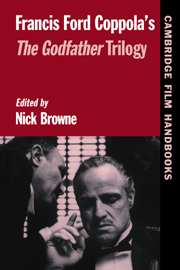Book contents
- Frontmatter
- Contents
- Acknowledgments
- List of Contributors
- Francis Ford Coppola's Godfather Trilogy
- Fearful A-Symmetries
- 1 If History Has Taught Us Anything … Francis Coppola, Paramount Studios, and The Godfather Parts I, II, and III
- 2 The Godfather and the Mythology of Mafia
- 3 The Representation of Ethnicity in The Godfather
- 4 Ideology and Genre in the Godfather Films
- 5 Family Ceremonies: or, Opera in The Godfather Trilogy
- Filmography
- Reviews of the “Godfather” Trilogy
- Select Bibliography
- Index
1 - If History Has Taught Us Anything … Francis Coppola, Paramount Studios, and The Godfather Parts I, II, and III
Published online by Cambridge University Press: 05 June 2012
- Frontmatter
- Contents
- Acknowledgments
- List of Contributors
- Francis Ford Coppola's Godfather Trilogy
- Fearful A-Symmetries
- 1 If History Has Taught Us Anything … Francis Coppola, Paramount Studios, and The Godfather Parts I, II, and III
- 2 The Godfather and the Mythology of Mafia
- 3 The Representation of Ethnicity in The Godfather
- 4 Ideology and Genre in the Godfather Films
- 5 Family Ceremonies: or, Opera in The Godfather Trilogy
- Filmography
- Reviews of the “Godfather” Trilogy
- Select Bibliography
- Index
Summary
In March 1970, Hollywood unemployment reached 42.8 percent, an all-time high. Despite a new ratings code and the increasingly sophisticated use of market research, theatrical films ran a distant second to the record industry in terms of annual gross revenues. Rising short-term interest rates and a seeming inability to comprehend the late-sixties mass audience contributed to what the trades characterized as a box office crisis. In response to this crisis, the studios increased production; by the summer of 1970, there was more than $100 million worth of negative in general release, the most ever.
The studios' decision to flood the market with product was misguided. Few films in 1970 made money, and even those that did seemed to have little in common. The box office leaders for the year were, in order, the disaster-thriller Airport, the auteur-comedy Mash, Patton (scripted by Francis Coppola), the topical Bob, Carol, Ted and Alice and Woodstock, and the big-budget musical Hello Dolly. Of all the successful releases, only Airport qualified as a blockbuster and, more importantly, only Airport seemed like something the studios could easily reproduce.
In 1970, Paramount ranked ninth in the industry, behind the six other majors and two independents, National General and Cinerama. The big news at Paramount at the time was its parent company Gulf & Western's various attempts to unload the legendary Melrose Avenue Paramount production facility, a move at one point blocked only by Gulf & Western's inability to get an adjacent property – a cemetary – rezoned.
- Type
- Chapter
- Information
- Francis Ford Coppola's The Godfather Trilogy , pp. 23 - 56Publisher: Cambridge University PressPrint publication year: 1999
- 1
- Cited by



